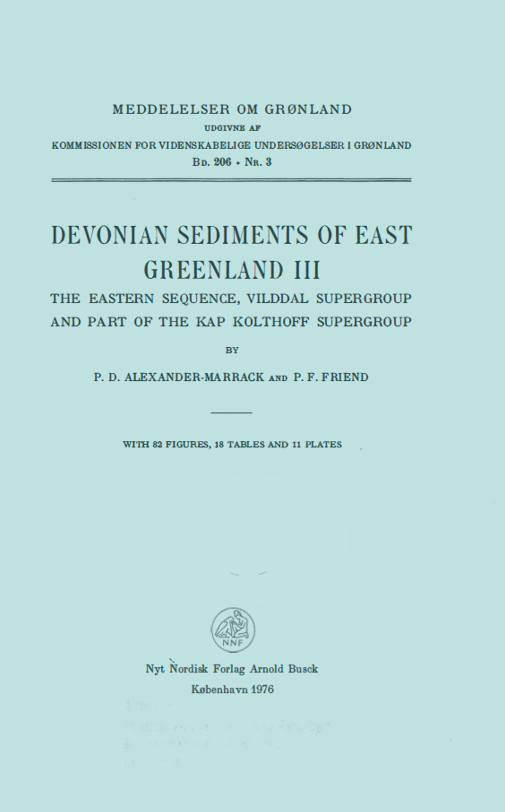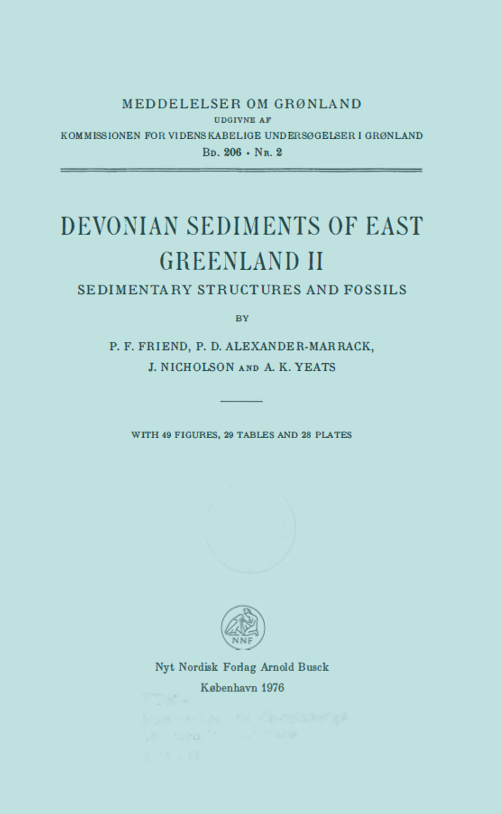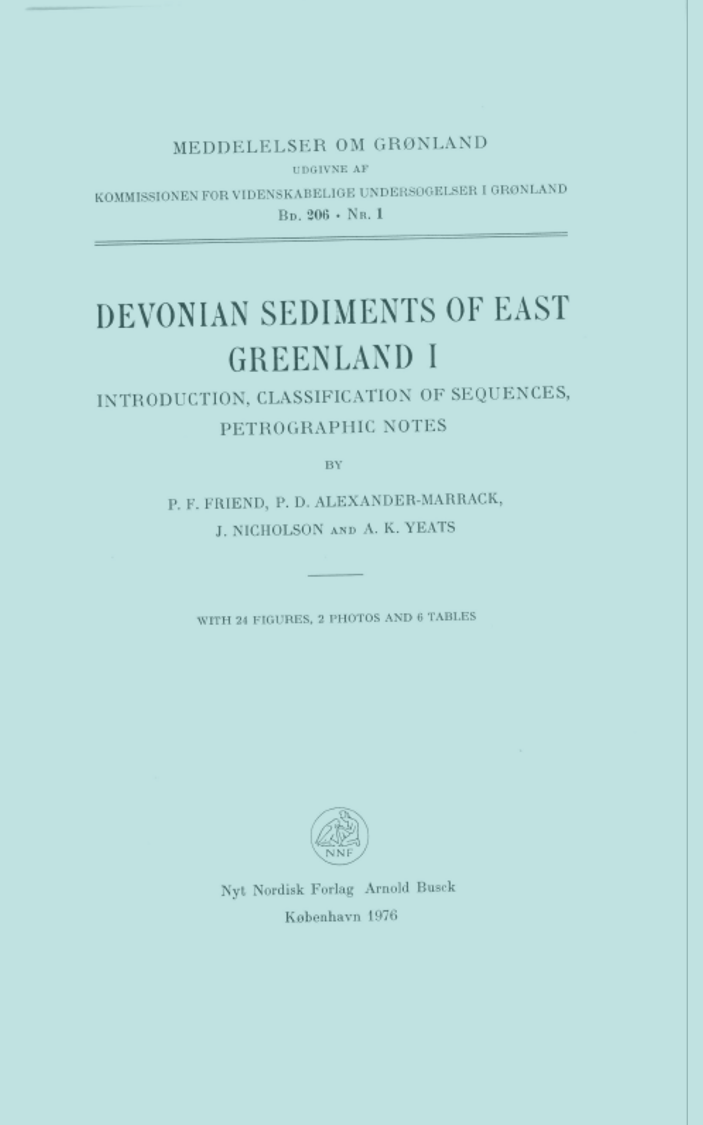Arkiver - Side 2
-
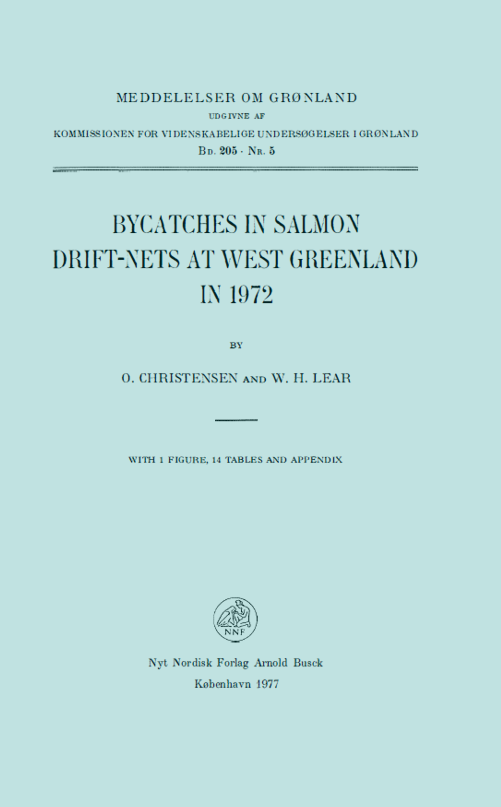
Meddelelser om Grønland
Årg. 205 Nr. 5 (1977)Introduction. s. 5
Gear and .Methods. s. 5
Results. s.8
Discussion. s. 25
Acknowledgements. s.29
References. s.29
Appendix. s. 31 -
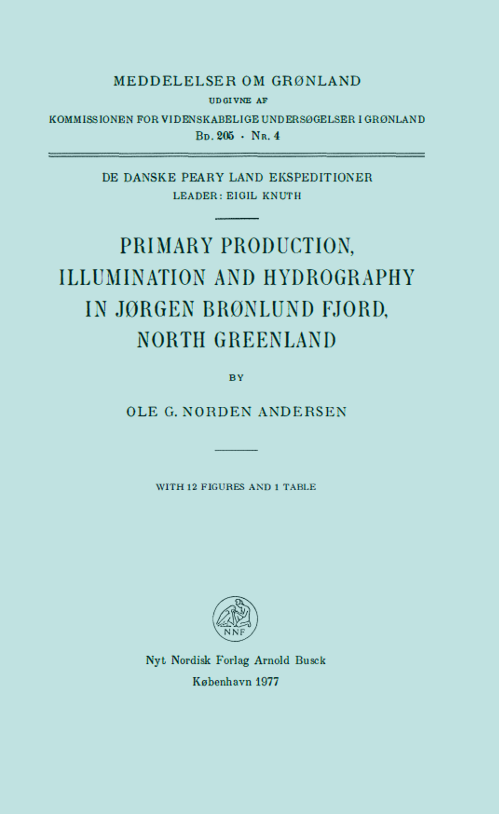
Meddelelser om Grønland
Årg. 205 Nr. 4 (1977)Introduction. s. 5
Material and methods. s. 6
Hydrography. s. 6
Temperature. s. 7
Salinity. s.8
Transparency. s. 11
The ice. s.11
Primary production and illumination. s. 20
Results. s.20
Discussion. s. 23
Resume. s. 25
Acknowledgements. s. 26
References. s. 27 -
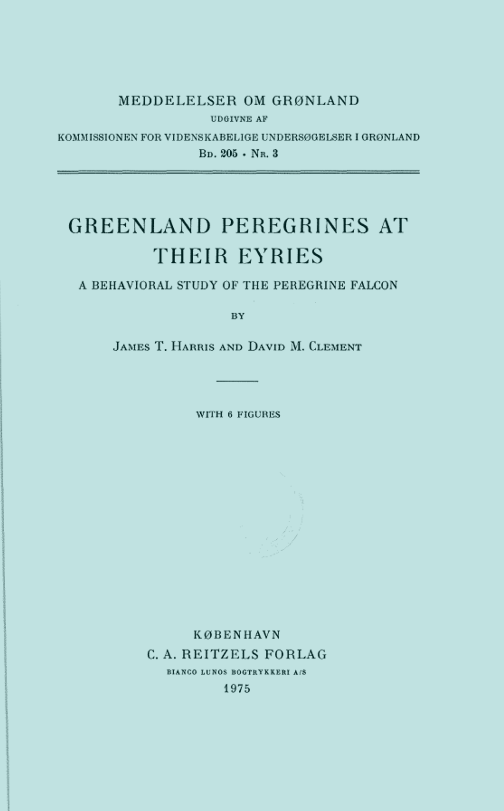
Meddelelser om Grønland
Årg. 205 Nr. 3 (1975)Introduction. s. 5
Field Methods. s.6
The Eyrie Locations. s. 8
Vocalizations. s. 9
Reliance on Sight. s. 10
Breeding Timetable. s. 11
Role Behavior. s.12
The Daily Cycle of Activity. s. 15
Prey, Hunting and Feeding. s. 18
Defense of the Eyrie. s. 24
Future Research. s. 26
Acknowledgements. s. 26
Literature Cited. s. 27 -
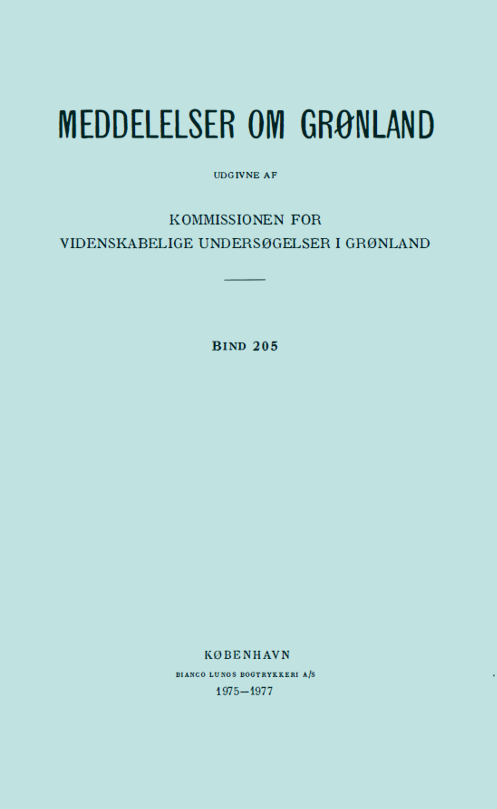
Meddelelser om Grønland
Årg. 205 Nr. 2 (1975)I. INTRODUCTION. s.5
II. PREVIOUS INVESTIGATIONS. s.5
III. MATERIAL. s.11
IV. MONOGENOIDEA. s.13
Acanthocotyle verrilli. s.13
Entobdella hippoglossi. s.13
Squalonchocotyle borealis. s. 14
The biological significance of the comparative anatomy of the vaginae and the morphology of eggs in the Hexabothriidae. s.22
Squalonchocotyle berlandi. s.23
V. TREMATODA (DIGENEA). s.28
Prosorhynchus squamatus. s. 28
Otodistomum veliporum. s. 32
Stephanostomwn davisi. s.35
Diptherostomum microacetabulum. s.38
Diptherostomum sp. s. 40
Steganoderma pycnorganum. s.42
Lepidophyllum steenstrupi. s.43
The Lepidophyllum-species and the generic relations within the family Steganodermatidae. s.47
Steringophorus furciger. s.50
Fellodistomum fellis. s.51
Fellodistomwn agnotum. s. 52
Anisorchis opisthorchis. s. 54
Neophasis pusilla. s. 56
Neophasis lageniformis. s.58
Neophasis oculatus. s. 60
The genus Neophasis STAFFORD 1904, its synonym Acanthopsolus OHDNER 1905 and its three species. s. 61
Lepidapedon elongatum. s. 62
Plagioporus idoneuss. s.64
Podocotyle atomon. s.65
Podocotyle reflexa. s. 67
The Podocotyle-species of Atlantic boreo-arctic waters. s. 69
Derogenes varicus. s.71
Genarches millleri. s. 73
Gonocerca phycidis. s. 75 Gonocerca crassa. s. 75
The differentiation between the Atlantic boreo-arctic Gonocercaspecies. s. 77
ilietahemiurus lerinseni. s. 77
Lecithaster gibbosus. s. 78
Gymnophallus deliciosus. s. 79
Gymnophallus choledochus. s. 79
List of hosts and their parasites. s. 80
List of parasites and their hosts. s. 82
List of references. s. 85 -
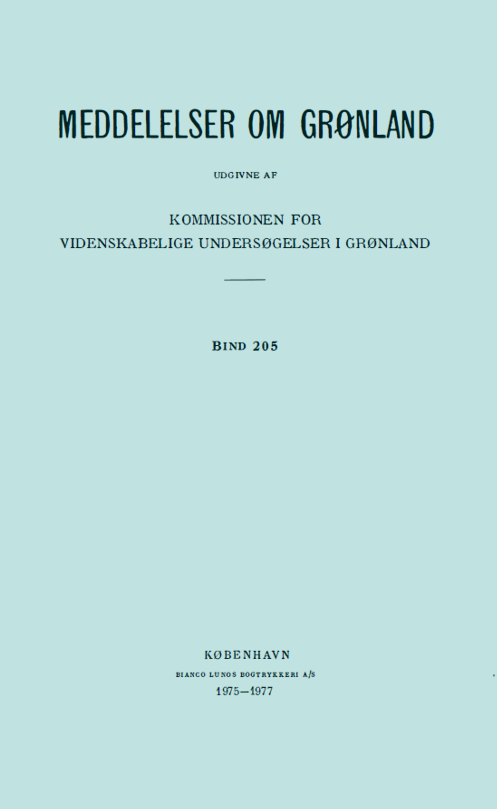
Meddelelser om Grønland
Årg. 205 Nr. 1 (1976)Introduction. s.5
General Part. s.6
Earlier Investigations. s.7
Description of the Area. s.7
Climate. s.10
Activity. s.13
Special Part. s.14
Red-throated Diver (GaPia s. stellata). s.14
Great Northern Diver (GaPia immer). s.14
Long-tailed Duck (Clangula hyemalis). s. 15
King Eider (Somateria spectabilis). s.15
Greenland Rock-ptarmigan (Lagopus mutus captus). s. 17
Ringed Plover ( Charadrius h. hiaticula). s.17
Turnstone (Arenaria i. interpres).s. 23
Knot (Calidris c. canutus). s. 27
Baird's Sandpiper (Calidris bairdii). s. 28
Schi0ler's Dunlin (Calidris alpina arctica). s.28
Sanderling (Calidris alba). s. 28
American Long-tailed Skua (Stercorarius longicaudus pallescens). s. 33
Ivory Gull (Pagophila eburnea). s.33
Glaucous Gull (Larus h. hyperboreus). s. 34
Arctic Tern (Sterna paradisaea). s. 34
Snow Bunting (Plectrophenax n. nivalis). s. 35
Completive Bird List for the Region. s. 36
Snow Goose (Anser caerulescens). s. 36
Pale-breasted Brent Goose (Branta bernicla hrota). s.36
Greenland Falcon (Falco rusticolu.s candicans). s. 36
Curlew Sandpiper (Calidris ferrugenea). s.37
Grey Phalarope (Phalaropus fulicarius). s. 37
Red-necked Phalarope (Phalaropu.s lobatus). s.37
Sabine's Gull (Xema sabini). s.37
Snowy Owl (Nyctea scandiaca). s.37
Hornemann's Redpoll (Carduelis flammea hornemanni). s.37
Lapland Bunting (Calcarius l. lapponicus). s. 38
Ringing and Measuring. s. 38
List of Recoveries to Date. s.39
Discussion. s.40
Faunistic.. s.41
Arrival and Pre-breeding Period. s. 44
Time of Breeding and :Non-breeding Years. s. 46
Post-breeding Flocks and Departure of the Waders. s. 49
Immatures and Non-breeders of Other Species. s. 51
Migration. s. 52
Census of Breeding Waders. s. 53
Literature. s. 55 -
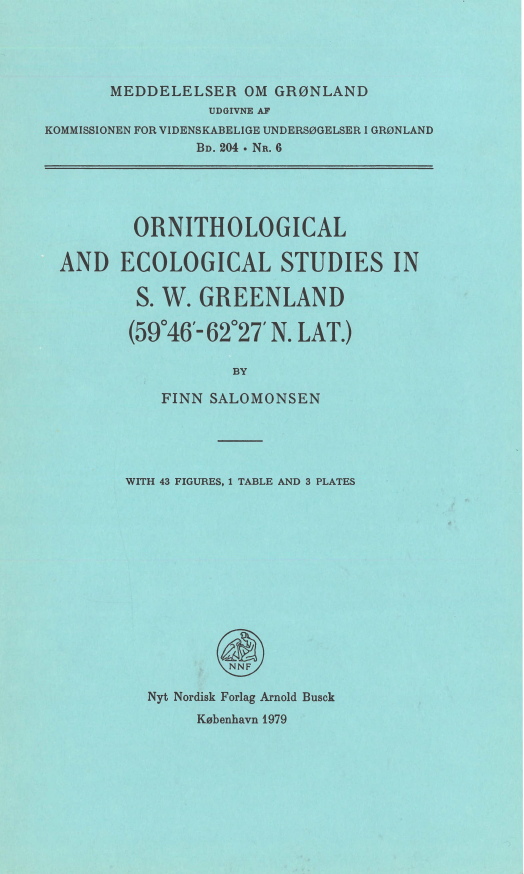
Meddelelser om Grønland
Årg. 204 Nr. 6 (1979)INTRODUCTION. s, 5
ITINERARY. s. 5
ACKNOWLEDGMENTS. s. 6
THE SUBARCTIC ZONE. s. 8
Boundaries and Climate in Greenland. s. 8
Vertical Zonation. s. 12
Animal Husbandry in the Subarctic Zone. s. 15
SUBARCTIC BIRDS IN GREENLAND. s.19
Fulmarus glacialis auduboni BONAPARTE. s.20
Larus ridibundus LINNAEUS. s.30
Turdus iliacus coburni SHARPE. s. 54
Tardus pilaris LINNAEUS. s. 59
Haliaetus albicilla groenlandicus BREHM. s. 66
Podiceps auritus (LINNAEUS). s. 78
Conclusions. s.79
ECOLOGY OF ARCTIC SEA-BIRD COLONIES. s. 81
Methods. s.83
Exposition. s. 84
Guano. s. 87
Cyanophycean Bands. s. 93
Caloplaca Arches. s. 94
The Coprophytes and their Biological Foundation. s. 99
The Hydrogen Ion Concentration in the Coprophyte Vegetation. s. 106
Previous Investigations on Coprophytes. s. 108
General Dscription of the Coprophyte Zones. s. 111
Composition and Characterization of the Coprophyte Vegetation. s. 118
Notes on Selected Species of Coprophytes. s. 130
Range Expansion of Coprophytes. s. 135
Seed-production. s. 138
Coprozoans. s. 139
THE SEA-BIRD COLONIES OF FREDERIKSHÅB DISTRICT. s. 141
F.1, Ikermiut Archipelago. s. 141
F.2, Qagssit Fjord. s. 148
F.3, Qeqertarssuaraq. s. 152
F.r., Ungilak. s. 153
F.5, Kuanersoq. s. 153
F.6, Qeqertaq. s. 155
F.7, Island off Nugarssuk . s. 155
F.8, Ivnaq. s.156 F.9, lvnarssuaq. s. 157
F.10, Tateraerunerit. s. 163
F.11, Ydre Kitsigsut. s. 165
Conclusions. s. 173
SEA-BIRD MIGRATION IN FREDERIKSHAB DISTRICT. s. 177
LOCAL BIRD-NAMES IN FREDERIKSHAB DISTRICT. s.192
A VISIT TO DYE II ON THE ICE-CAP WITH NOTES ON THE TRANSGLACIAL MIGRATION. s. 196
REFERENCES. s. 202 -

Meddelelser om Grønland
Årg. 204 Nr. 5 (1978)Introduction. s.5
Field work . s. 5
Laboratory work. s.6
Pollen analyses . s.6
Macrofossil analyses. s.7
Investigated transects. s. 16
Section LM. s.16
Section ER. s.22
Section QD. s. 26
Section F. s.32
The influence of the landnam on the vegetation. s. 35
South Greenland. s.35
Scandinavia, Faroe Islands and Iceland. s.37
Acknowledgments. s.39
References. s. 40 -
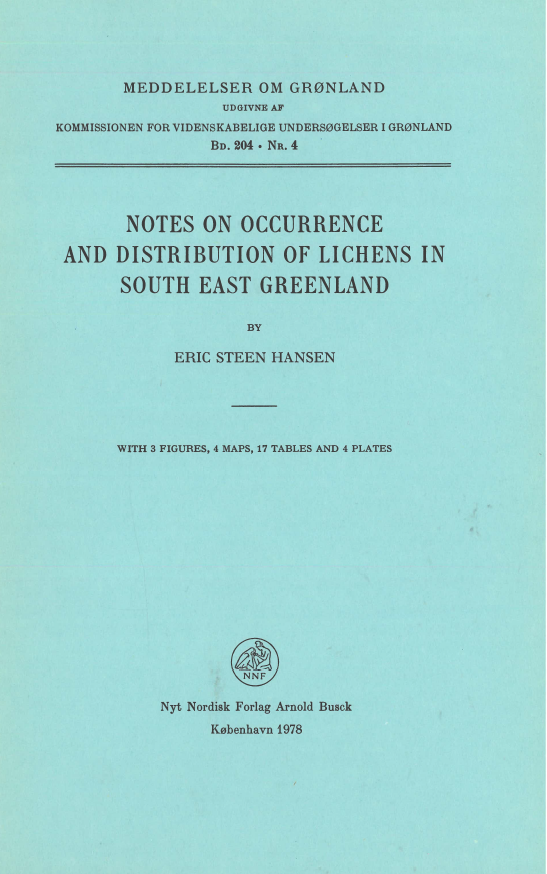
Meddelelser om Grønland
Årg. 204 Nr. 4 (1978)Introduction. s. 5
Climatic conditions at three stations in South East Greenland. s. 6
Situation and geological conditions of investigated localities in South East Greenland. s. 8
Number of lichen species found in the Skjoldungen-, the Angmagssalik- and the Kangerdlugssuaq area. s. 12
The lichen vegetation in the three areas. s. 17
1. Lichens growing on twigs and branches of Juniperus communis L. s.18
2. Lichens growing on dead plant fragments under shrubs of Salix glauca L. s.18
3. Lichens occurring on soil under willow-shrubs. s.19
4. Lichens occurring among mosses under willow-shrubs. s.20
5. Lichens occurring in plant communities mainly composed of herbaceous phanerogams. s. 22
6. Lichens growing on mainly dry, steppe-like slopes. s. 25
7. Lichens growing on mainly acid soil on slopes rich in grasses and sedges. s. 27
8. Lichens growing in fens and marshes. s.27
9. Lichens growing in snowbeds and on N-facing slopes with a snow cover of long duration. s. 28
10. Lichens occurring on the ground among boulders and stones on talus slopes and landslides. s. 32
11. Lichens occurring in open, gravelly fell-fields. s. 34
12. Lichens growing in dwarf shrub heaths dominated by Empetrum hermaphroditum (LGE.) HAGERUP and Vaccinium uliginosum L. ssp. microphyllum LGE. and in other types of dwarf shrub heath. s. 40
13. Lichens occurring on alkaline soil ·derived from calcareous rocks and dykes. s.51
14. Saxicolous lichens. s. 52
a. Lichens growing on basic rocks and dykes and calcareous rock fragments. s. 52
b. Ornithocoprophilous lichens occurring mainly or exclusively on "bird stones" or projecting rocks with a thin cover of guano on the top or otherwise influenced by guano. s. 52
c. Lichens mainly growing on rocks, boulders and stones composed of granite, gneiss or basalt and without visible influence of bird excrements. s. 56
Distribution maps of lichens in Greenland. s. 64
Acknowledgements. s. 64
Literature. s. 64 -
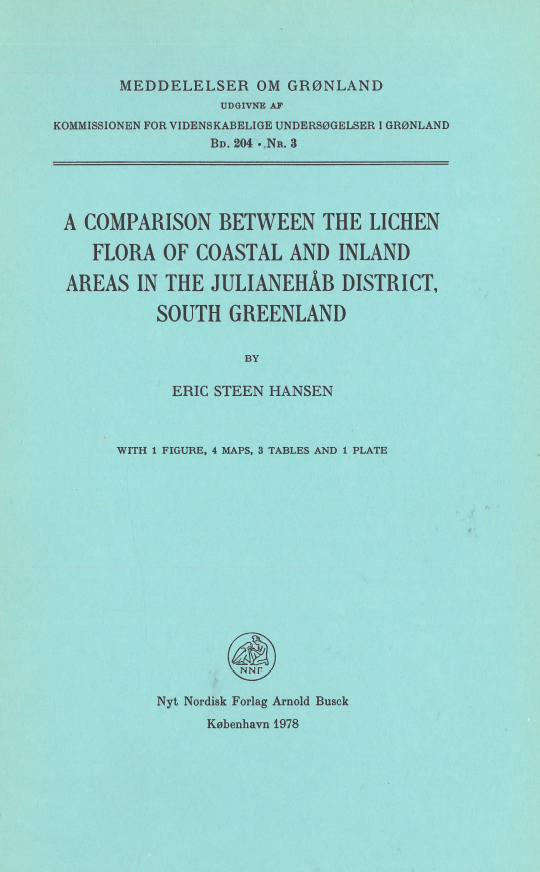
Meddelelser om Grønland
Årg. 204 Nr. 3 (1978)Introduction. s. 5
Climatic conditions at two stations in the Julianehab District. s.5
Situation and geological conditions of eight localities in the Julianehab District. s.6
Number of lichen species found in the inland and coastal areas. s. 8
Ecological preferences of the lichen species. s.13
Lichens of particular interest. s.23
Distribution maps of lichens in Greenland. s. 26
Acknowledgements. s.28
Literature. s.30 -
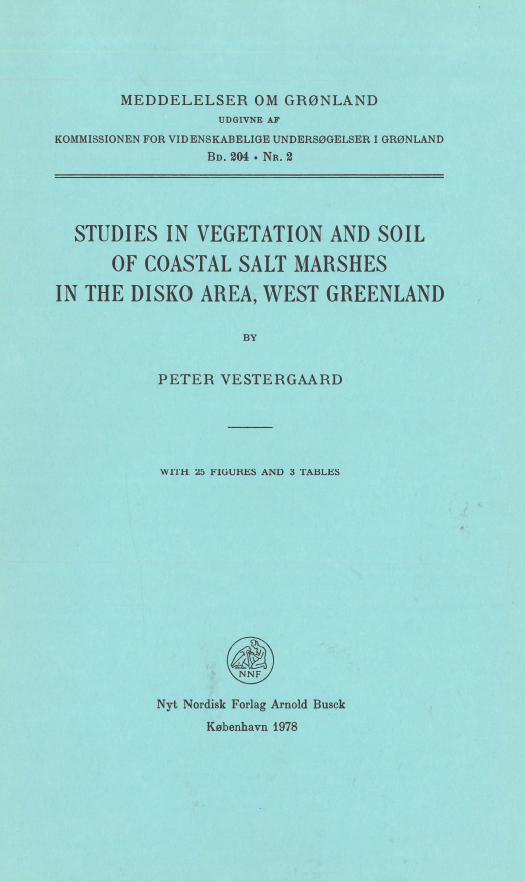
Meddelelser om Grønland
Årg. 204 Nr. 2 (1978)Introduction. s. 5
Field methods. s. 8
Laboratory methods. s. 10
Treatment of the field data. s.10
Soil analyses. s.13
Treatment of the soil data. s. 14
The localities. s.15
General features. s. 15
Locality I . s. 17
Locality II . s. 18
Locality III. s. 19
Locality IV. s.21
Locality V. s.22
Locality VI. s. 24
Locality VII . s.26
Vegetational structure of the salt marshes. s. 33
Distribution of the species within the salt marsh. s.33
Similarity in species composition. s.33
Species number. s.34
The lower salt marsh . s.36
The upper salt marsh. s.37
Soil conditions. s.38
Texture. s. 38
Edaphic factors. s.39
Water-extractable Na, Mg, Ca, K and Cl. Specific conductivity. s.40
Adsorbed Na, Mg, Ca and K. s. 41
Organic matter. s.42
Cation exchange capacity (CEC). s.42
Water content. s. 43
Soil salinity . s.43
pH. s.44
Phosphorus. s. 44
EDTA-extractable Cu, Pb, Zn and Ni. s. 44
Edaphic factors and the distribution of the plants. s. 45
Conclusion. s. 48
Acknowledgements. s. 49
Literature. s.50 -
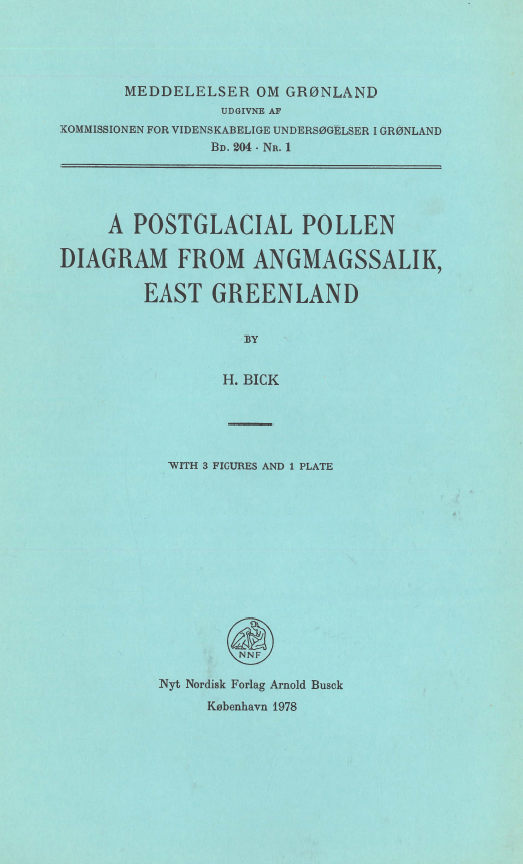
Meddelelser om Grønland
Årg. 204 Nr. 1 (1978)1. Introduction 5
2. Location of the core. s. 5
3. Recent vegetation . s. 5
4. Methods . s. 7
4 a. Field methods . s.7
4 b. Laboratory methods. s.7
5. Lithology . s. 8
6. Pollen diagram . s.9
6 a. Pollen sum . s.9
6 b. Zonation and arrangement of pollen types . s. 10
7. Results and discussion .s.12
7 a. Problems in interpretation .s. 12
7 b. Zones. s. 12
1. Zone ANG-A . s.12
2. Zone ANG-B . s.13
3. Zone ANG-C . s. 14
4. Zone ANG-D . s.15
5. Zone ANG-E .s.16
6. Zone ANG-F . s.16
7 c. Remarks on separate pollen curves . s.17
7 d. Remarks on concentration values . s.18
7 e. Climatic fluctuations . s. 18
References . s. 21
Acknowledgements. s.22 -
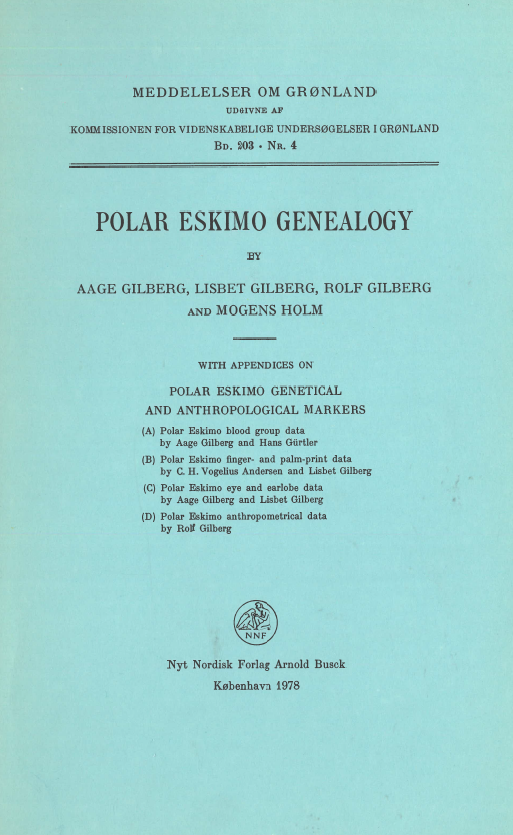
Meddelelser om Grønland
Årg. 203 Nr. 4 (1978)PREFACE. s. 4
INTRODUCTION. s. 5
Collection of genealogical data. s. 5
Origin of Polar Eskimo family data. s. 6
Method. s. 7
Storing of Polar Eskimo genealogical data. s. 8
Definition of the Polar Eskimo population. s. 8
POLAR ESKIMO REGISTER . s. 12
Extended family diagram. s. 12
Mating. s. 12
Family number. s. 12
Children. s. 13
Sex. s. 13
Identity code. s.14
Ancestor code. s. 14
Non-Polar Eskimos. s. 14
Dates of birth and death. s. 15
Places of birth and death. s. 17
Code for deaths of children. s. 17
CLASSIFICATION OF THE POLAR ESKIMO FAMILY SIB
GROUP SIZE. s. 18
Using sib group size. s. 18
ANCESTOR INDEX. s. 20
Ancestor Index Total Value. s. 20
Ancestor Index Partial Values. s. 20
Origin code. s. 20
Complete Ancestor Index code. s. 22
INBREEDING AMONG THE POLAR ESKIMOS. s. 22
Inbreeding coefficient. s. 23
Table of common ancestors in 69 Polar Eskimo matings. s. 24
ACKNOWLEDGEMENTS. s. 26
REFERENCES. s. 27
EXTENDED FAMILY DIAGRAMS with key to symbols. s. 28-132
APPENDICES. s. 133
(A) Polar Eskimo blood goup data. s. 134
(B) Polar Eskimo finger- and palm-print data. s. 138
(C) Polar Eskimo eye and earlobe data. s. 143
(D) Polar Eskimo anthropometrical data. s. 145 -
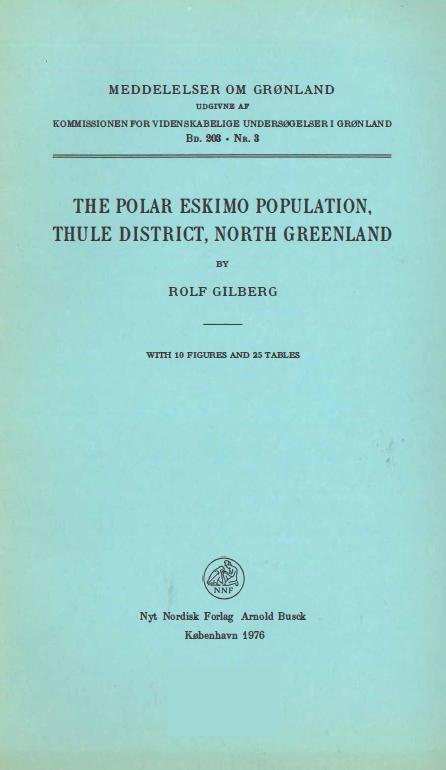
Meddelelser om Grønland
Årg. 203 Nr. 3 (1976)Introduction. s. 4
1. Location. s. 5
2. Definition of the Polar Eskimo population. s. 6
3. Methods. s. 8
Collection of data. s. 8
Punch card census. s. 8
4. Some authors' remarks on the Polar Eskimo population. s.12
5. Births. s.17
Number of births. s. 17
Distribution of births by months. s. 18
Twins. s. 21
6. Mortality. s. 23
Death rate. s. 23
Duration of life. s. 26
Infant mortality. s. 26
Child mortality. s. 27
Adult mortalitys. 27
Causes of death. s. 27
7. The difference between the numbers of births and deaths. s. 31
8. Sex ratio. s. 31
Polar Eskimo sex ratio. s. 31
Sex ratio of other Eskimo groups. s. 33
9. The family. s. 33
Reproduction rate. s. 33
Family size. s. 35
Sterility. s. 36
Adoption and family planning. s. 38
10. Migrations and admixture with other ethnic groups. s. 38
11. Population structure. s. 40
The population on December 31, 1969. s. 40
The population on December 31, 1973. s. 45
Comparison of the years 1903, 1924, 1943, 1953, 1963, 1969, 1973. s. 45
12. Development of the Polar Eskimo population, 1893-1973. s. 47
Phase I (1893-1903). s. 47
Phase II (1903-1922). s. 47
Phase III (1922-1934). s. 50
Phase IV (1934-1953). s. 51
Phase V (1953-1969). s.51
Phase VI (1969-1973). s. 52
13. Conclusion. s. 52
Acknowledgements. s. 53
References. s. 54
Appendix: Polar Eskimos Bibliography. s. 57 -
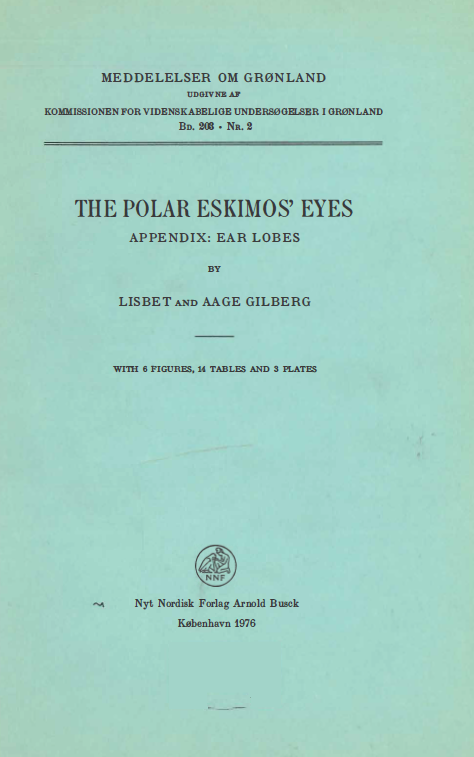
Meddelelser om Grønland
Årg. 203 Nr. 2 (1976)Introduction. s. 5
I. Iris Colour. s. 7
Assemblage of Materials. s. 8
Working up of Material. s. 9
II. Eye Surroundings. s. 17
A. Eye Folds. s. 17
Problems of Heredity. s. 21
Present Investigations. s. 23
B. Eye Fissure (rima palpebralis). s. 29
C. Eyebrows. s. 31
Acknowledgements . s. 34
Bibliography. s. 35
Appendix: Ear Lobe form. s. 37
Colour Plates -
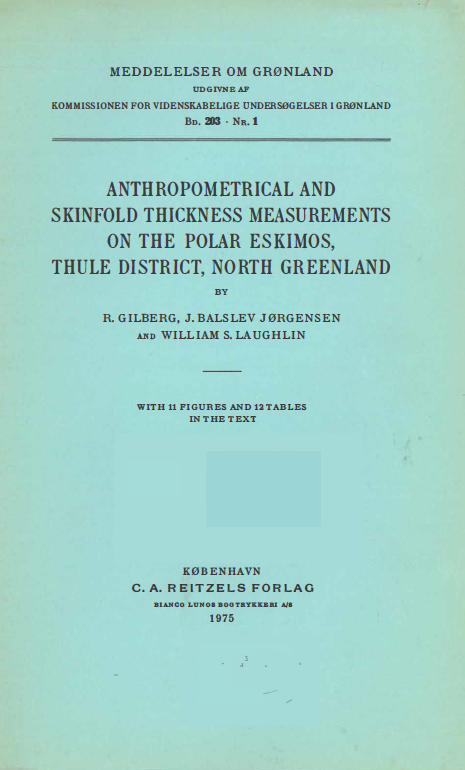
Meddelelser om Grønland
Årg. 203 Nr. 1 (1975)Introduction. s. 5
Anthropometrical Investigations. s. 6
The Material. s. 6
Body Measurements. s.6
Circumferences. s. 9
Measurements of the Head. s.12
Conclusion. s.13
Skinfold thickness. s. 15
Skinfold thickness over the triceps brachii . s.16
Subscapular skinfold thickness . s. 17
Skinfold thickness over crista iliaca. s. 22
Skinfold thickness over the triceps surae. s. 22
Conclusion. s. 22
Literature. s. 23 -
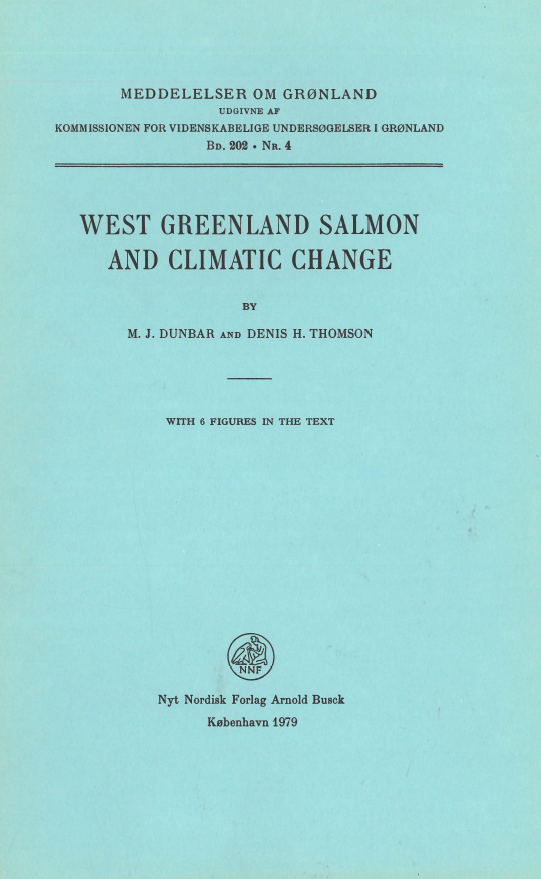
Meddelelser om Grønland
Årg. 202 Nr. 4 (1979)Introduction. s. 5
The climatic Cycle. s. 6
The Salmon in West Greenland. s.9
Salmon migration and changing oceanographic conditions. s.12
References. s. 17 -
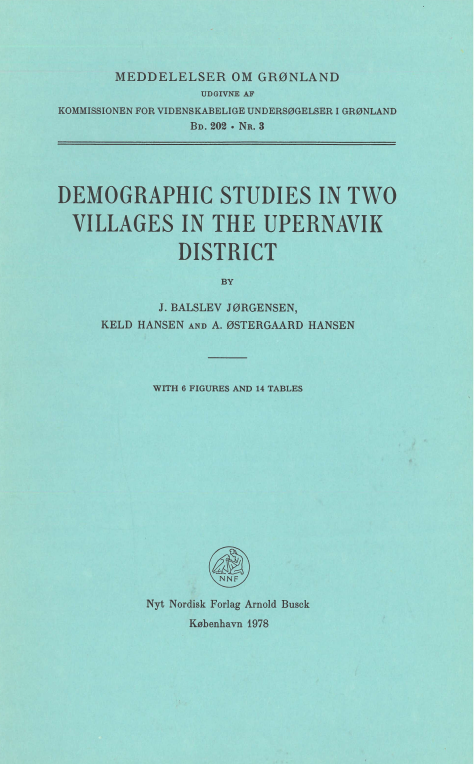
Meddelelser om Grønland
Årg. 202 Nr. 3 (1978)Preface. s. 2
Introduction. s.5
General discription of the villages. s. 6
Generations and origins. s. 8
Population structure. s.13
Observations on fertility. s.16
Population developments in the five years following these investigations. s.18
Literature. s. 20 -
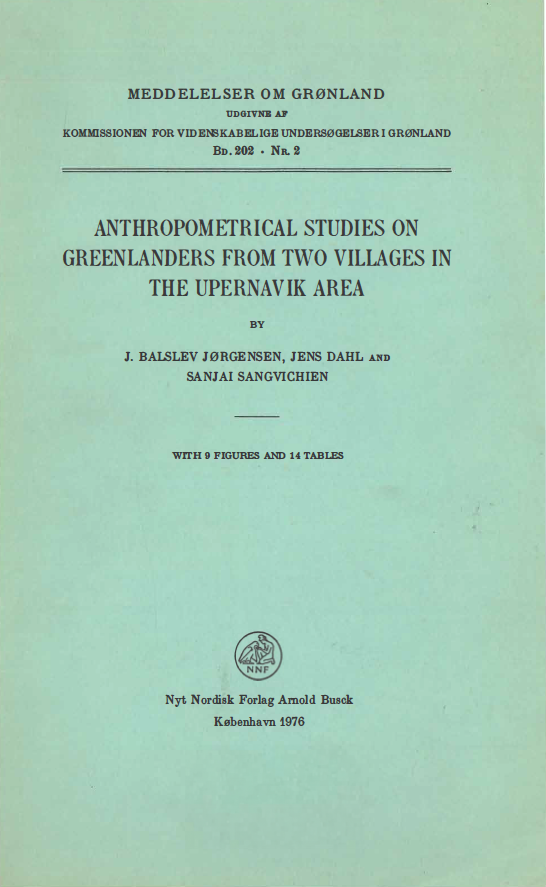
Meddelelser om Grønland
Årg. 202 Nr. 2 (1976)Preface . s. 5
Material and technique. s. 5
Measurements of the Body. s.8
Measurements of the Head. s.15
Comparisons. s.16
Conclusion. s. 20
Summary. s.20
Literature. s. 24 -
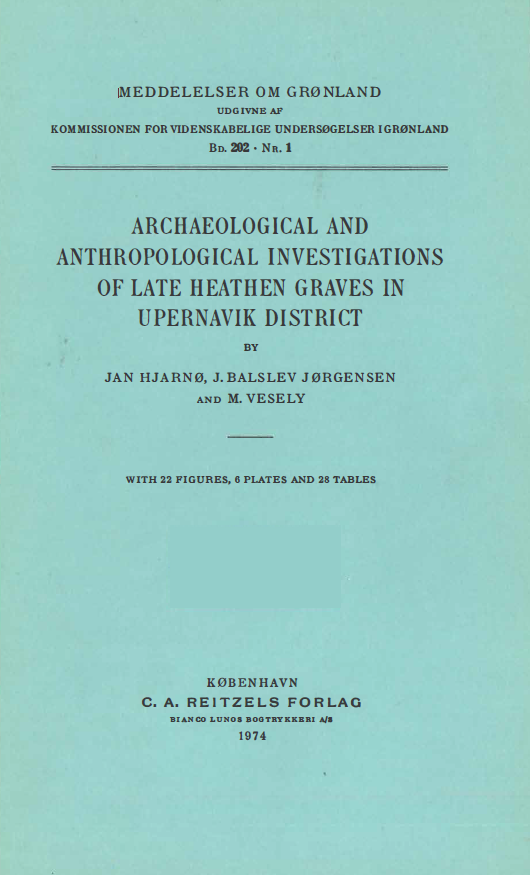
Meddelelser om Grønland
Årg. 202 Nr. 1(Part II) (1974)Part II
Anthropological Investigations of late Heathen Graves. s.1
Introduction. s. 3
Technique.s. 4
The Material. s. 5
Measurements on the Skull. s. 8
Measurements on the Long Bones. s.17
Discontinuous Traits. s. 25
Pathologies. s. 30
Literature. s. 36Collective tables: 15, 16, 17, 19, 21, 22, 23, 24, 26, 28 (The missing tables were probably never printed)
-
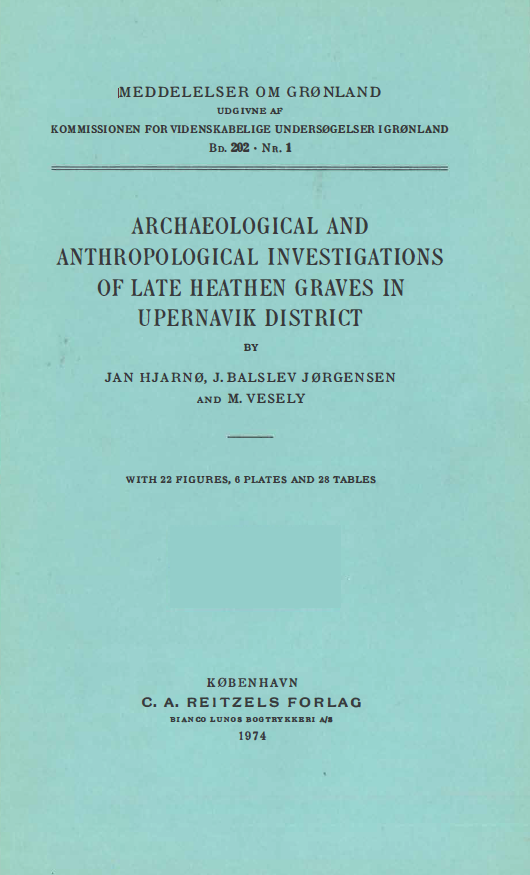
Meddelelser om Grønland
Årg. 202 Nr. 1(Part I) (1974)Part I
Preface. s. 5
Eskimo Graves from Upernavik District.s. 7
Introduction. s.9
Location of the Graves. s.10
Dating of the Grave Goods.s.28
Conclusion. s. 34
Bibliography.s.35
Plates.s. 36Collective tables: 15, 16, 17, 19, 21, 22, 23, 24, 26, 28 (The missing tables were probably never printed)
-
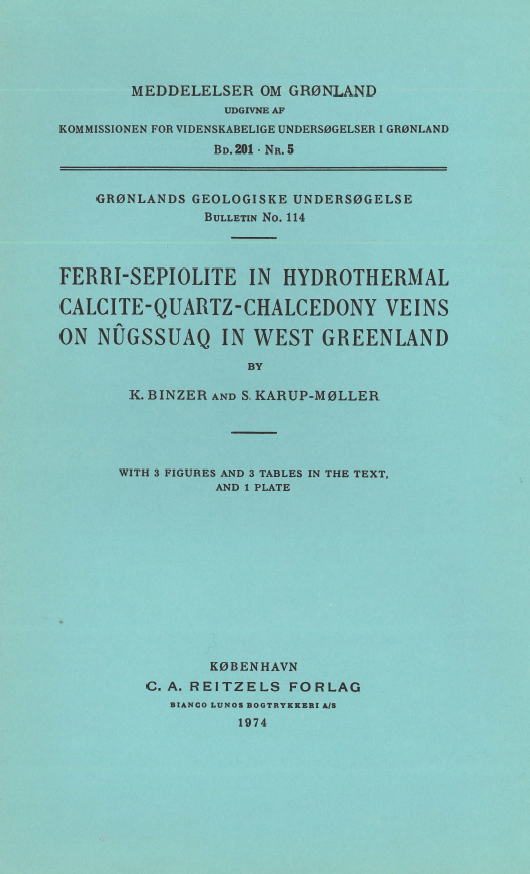
Meddelelser om Grønland
Årg. 201 Nr. 5 (1974)Introduction. s. 5
Stratigraphic position of the mineral veins. s. 5
Mineral description of ferri-sepiolite. s. 6
Physical properties. s.6
X-ray crystallography. s. 7
Chemistry. s. 10
Mineral relationships. s. 10
The P-T conditions of mineral vein formation. s. 12
Discussion. s. 13
Acknowledgements. s. 15
References. s. 16 -
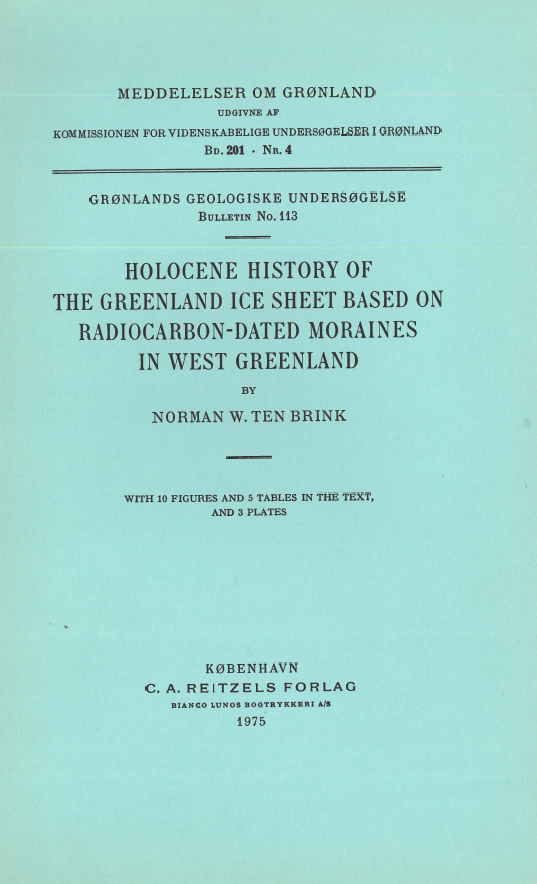
Meddelelser om Grønland
Årg. 201 Nr. 4 (1975)Introduction.s. 5
Objectives, location and background. s.5
Geological-geomorphological setting. s. 6
General methods of study. s. 8
Major moraine systems and glacial chronology. s. 9
Nature of the evidence.s. 9
Major moraine systems. s. 10
General. s. 10
Methods of delineation. s. 11
Methods of dating. s. 13
Type areas and ages. s. 17
Glacial chronology. s. 21
Comparison with other areas. s. 28
West Greenland. s. 28
East Greenland. s. 29
Eastern Canadian Arctic. s..34
Discussion and glacial-climatic implications. s. 36
Summary. s. 38
Acknowledgements. s. 39
References. s. 41

